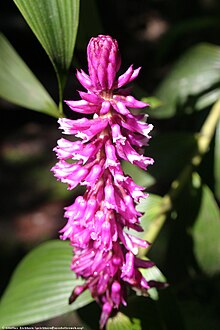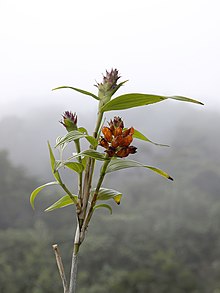Elleanthus
| Elleanthus | ||||||||||||
|---|---|---|---|---|---|---|---|---|---|---|---|---|

Elleanthus brasiliensis |
||||||||||||
| Systematics | ||||||||||||
|
||||||||||||
| Scientific name | ||||||||||||
| Elleanthus | ||||||||||||
| C. Presl |
The genus Elleanthus from the family of orchids (Orchidaceae), with over 100 species distributed in Central and South America. The plants are characterized by dense clusters of strikingly colored flowers .
description
Elleanthus includes perennial plants that grow epiphytically or terrestrially. The roots are surrounded by a velamen two to five cell layers thick . The individual rungs are close to each other on the rhizome . They are not thickened, upright to prostrate, occasionally branched and slightly woody. The shoot is densely covered with two-line leaves that do not have a petiole . These are stiff, usually crinkled along numerous leaf veins, rarely smooth and folded along the midrib.

The terminal inflorescence is racemose or almost dense like a head. The flowers are spirally or two-lined, usually they are close together and numerous, rarely the inflorescence is loose and few flowers. The bracts are large, but not foliage-like, they are often conspicuously colored. The tubular flowers are rather small, but colorful. The petals are shaped the same except for the lip and do not grow together. The sepals are seldom spread out, the dorsal sepal is concave, the lateral sepals are connected and slightly protruding at their base. The petals are usually thinner in texture. The lip is longer than sepals, concave, the front edge fringed, the base bulged with one or two distinct calluses. The column is straight, does not protrude beyond the point of attachment at the ovary (without a foot), but with an asymmetrical base, at the top it is winged. The scar consists of an area. The dividing tissue between the stigma and the stamen (rostellum) is triangular. The stamen is bent down towards the columnar axis or stands parallel to it, it contains eight unevenly shaped, oval pollinia .
distribution
Elleanthus grows widespread in Central and South America. The area extends in the north to Mexico and the Caribbean, in the south to Peru and the south of Brazil. Elleanthus occurs from sea level to 3000 meters above sea level. The greatest biodiversity can be found in the Andes.
The species grow epiphytically or lithophytically in moist forests.
Systematics
The genus Elleanthus forms together with Sertifera and Sobralia the tribe Sobralieae. Within the subfamily Epidendroideae this tribe represents a basal line. In the genus Elleanthus one differentiates about 124 kinds. A list of the recognized species can be found in R. Govaerts.
Karl Bořiwog Presl described the genus in 1827. The type species is Elleanthus lancifolius . The genus Epilyna , established by Rudolf Schlechter in 1918, is considered by some authors to be synonymous with Elleanthus . The generic name Elleanthus is derived from the ancient Greek cubit , referring to either the mythological Helle or Helena , and ἄνθος ánthos for "blossom" or "flower".
supporting documents
Most of the information in this article comes from:
- Leslie A. Garay: 225 (1). Orchidaceae (Cypripedioideae, Orchidoideae and Neottioideae) . In: Gunnar Harling, Benkt Sparre (ed.): Flora of Ecuador . tape 9 , 1978, ISSN 0347-8742 , p. 57 .
- Alec M. Pridgeon, Phillip Cribb, Mark W. Chase (Eds.): Genera Orchidacearum. Epidendroideae (Part one) . 2nd Edition. tape 4/1 . Oxford University Press, New York and Oxford 2005, ISBN 0-19-850712-7 , pp. 598-599 .
Individual evidence
- ↑ a b Rafaël Govaerts (Ed.): Elleanthus. In: World Checklist of Selected Plant Families (WCSP) - The Board of Trustees of the Royal Botanic Gardens, Kew . Retrieved July 10, 2018.
Further information
- List of orchid genera
- Elleanthus - the genus , by Nina Rach
